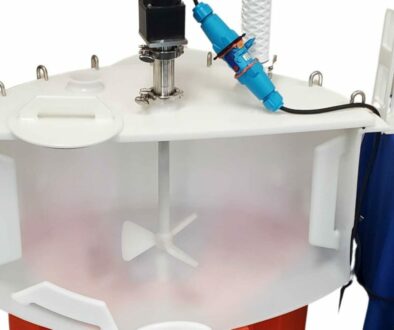Mixing Impeller vs Propeller: Selecting the Optimal Agitator for Your Bioprocess System
Impeller vs Propeller – How to choose the correct agitator for your mix tank.
The bioprocessing industry has been growing at a rapid pace, and with this growth comes the need for efficient and effective mixing equipment. White Mountain Process (wmprocess.com) understands the intricacies of mixing and agitation. One of the most common questions we encounter is choosing between impellers and propellers for bioprocess systems. This blog will delve deep into the differences between impellers and propellers and how to select the optimal agitator based on tank size and material.
What are Impellers and Propellers?
Impellers:
These are rotors or blades that rotate in a liquid, inducing flow and promoting mixing. Impellers come in various designs, typically a radial flow, axial flow, or high shear design. They can be used for a range of applications, from gentle low-shear mixing to high-shear blending.
Propellers:
Often likened to airplane propellers, these are axial flow agitators that are down-pumping in nature. They are most effective in producing top-to-bottom circulation in a tank, providing the proper orientation of the mixer in the vessel or center vertical mount agitator, with tank baffles to eliminate swirling.
Factors to Consider: Tank Size & Material
Tank Size:
A general rule of thumb for typical mixing application (low viscosity/low shear blending) is the impeller, or impellers, to have a D / T ratio of 0.30, so the impeller diameter is approx. 1/3 of the mixing tank diameter. Tank geometry is key to producing mixing results depending on batch size, liquid levels, etc.
Material Viscosity:
Low Viscosity Liquids: with their high axial flow, propellers are suitable for less viscous materials as they can easily circulate the liquid.
High Viscosity Liquids: Impellers, especially those with pitched blades or anchor sweep style agitators, are adept at handling thicker liquids, ensuring that the material doesn’t remain stagnant at the bottom.
Benefits of Impellers:
- Versatile design options cater to a wide range of applications.
- Effective in preventing dead zones in the tank.
- Suitable for both high and low-viscosity materials.
- Available in fabrications for polishing in biopharma applications
Benefits of Propellers:
- Ideal for top-to-bottom circulation.
- Effective for large tank volumes.
- Optimal for low-viscosity liquids.
Materials of Construction for propellers (cast marine props) are typically stainless steel, 304ss, or 316ss. Fabricated impellers can be 316Lss with polish and electropolish, Hast C276, Super Allow, USP VI PP, and ETFE coated stainless, and mixing impellers are available in a wide range of other exotic alloy materials.
Conclusion:
Choosing between impellers and propellers for your bioprocess system depends largely on the size of your tank and the viscosity of the material you are processing. While there is no one-size-fits-all answer, understanding the strengths and limitations of each agitator can guide you to make an informed decision. White Mountain Process is always at your service to help you select the best equipment tailored to your needs. Contact us today for more insights and assistance.




